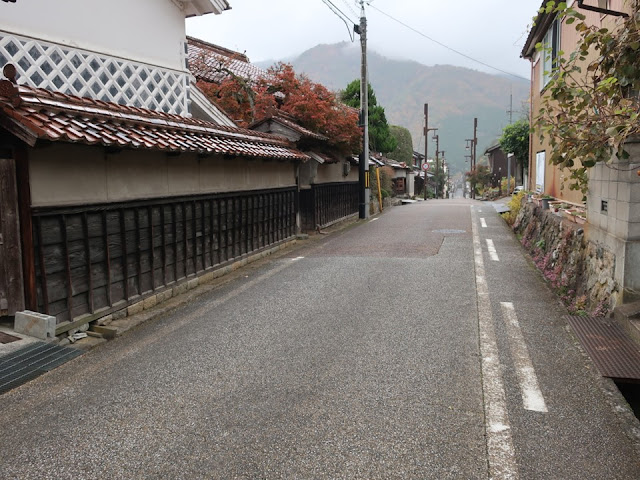Chizu Town in Tottori prefecture in western
Japan has been a junction (fork). It is on the highway which links Tottori and
Himeji, and on the road to Tsuyama. The great daimyo
(feudal lord) of Tottori stayed a night when he went to Edo (Tokyo) and when he
returned. The town thrived as the junction, so travelling merchants
stayed at Chizu and did business. It was finally prohibited in 1844 by the
daimyo lord of Tottori. It was the longstanding post town which is already written
in an official book in the 8th century. I’ll introduce its history
museum with Chizu Town. I felt the vitality of the
locals.
鳥取県東南部の智頭町は、鳥取城下と姫路城下を結ぶ因幡街道(上方往来)から、津山城下へ向かう備前街道が分岐する宿場町です。鳥取藩主池田家(32万)の参勤交代のための本陣もあり、たいへん栄えました。「あまり繁盛したので、1844年にはとうとう小売商人の逗留を禁止しました」と看板に書かれていました。旅をやめて智頭宿で商売をする人が現れたのですね。日本書紀に、宿駅だということが記録されているので、古代からの宿場です。智頭町の歴史資料館の民俗資料とともに紹介します。智頭の人々の生きる力を感じました。
The road remains the atmosphere of the historical highway.
旧街道は雰囲気を残しています。
The is a signpost at the fork, which was built in 1879. It shows the direction to Tottori, Himeji and Tsuyama which were written in the old Japanese characters.
二つの街道の合流点に置かれた明治12(1879)年につくられた道標です。崩し字で、読めません。「南 み起(右)ひめじ(姫路)大坂 飛だり(左)鳥とり」「東 みぎ 鳥と里 飛だり つやま 備前」のようです。
It is the site of the daimyo lord’s inn. Its layout is written o the guideboard. The inn was used over 178 times between 1648 and 1862 (Edo period).
中町公民館の横に御本陣跡の石碑があり、看板にはレイアウトが書かれています。1648年から214年間に、178回通行されたそうです。
The residence of Ishitani family、石谷家住宅
The residence is the most attractive tourist spot. They were village head in the Edo period (1603~1868); they built a fortune by a forestry and a landlord business in the following Meiji period (1868-1912). Chizu is a famous production area of Japanese cedar.
It took ten years to build the house since 1919. The family live in the site (10,000sqm) even until now. It is very rare because most of huge houses in countryside were donated to the government; maintenance fees are so expensive and families often move to cities like Tokyo.
町の見所は石谷家住宅です。石谷家は江戸時代の大庄屋で、明治に入り山林経営(智頭は杉で有名な町)と地主経営で財をなした家です。
1919(大正8)年から10年をかけて建てられた家は、門を街道からさげています。石谷家は、3000坪の敷地の一部にお住まいになっています。地方の大きな旧家は、自治体に寄付をして家主は東京など別の土地に住むことが多い中で、珍しいです。
There are massive beams of pine trees above the earthen floor.
広い土間の上には、太い松の梁があります。
We can see roofing tiles (kawara) from the second floor. Those are beautiful especially in a rainy day.
二階からは、美しい屋根が見えます。
The tiled roofs in front of autumn leaves fascinate us.
紅葉をバックに。雨の日の瓦屋根には惹きつけられます。
The garden is designated as National Scenic Place.
庭は国登録名勝地です。
There is a shrine above the master’s room.
主人の間の真上に神殿の間があります。
Suwa Shrine、諏訪神社
Suwa Shrine in the town has four pillars around its main shrine building (honden). It is same as its head shrine (Suwa Taisha) in central Japan.
町の諏訪神社の本殿の周りには四本の柱が立てられています。長野県の諏訪大社と同じです。
The four pillars are renewed every six years and the “On-bashira (pillar)” festival is held at that time. It’s really brave one.
7年ごと(数え年のため、実際は6年に一度)の御柱祭で立て替えます。長野県の諏訪大社に負けない勇壮な祭りです。
Reference、参照:https://chizukankou-kurashiya.jp/event/spring/suwajinjya/
Locals at the shrine office welcomed us. It’s interesting to talk with them.
社務所では、町の方が温かく迎えてくれました。地元の方との会話は楽しいですね。
Chizu history museum、智頭町歴史資料館
The museum is away from the center of Chizu. It was a school. We have to ask the staff to open the exhibition room after arriving.
資料館は、宿場から少し離れた静かな土師地区にあります。昔の学校を利用した資料館です。展示室の鍵を開けていただく必要があるので、事前連絡をお勧めします。
The old daily goods and farming equipment are exhibited in the former library.
民具農機具の展示は元の図書室です。
Each article has a trace which someone used. The paper raincoat is waterproof. The astringent juice of the persimmon was coated at first, then it was dried. Afterwards, oil was coated several times. Workers often used them. Its owner’s name was written on the raincoat. The photos above show us how the coats were used.
どの民具も、人が使ったことを感じさせます。桐油(とうゆ)合羽は、和紙に柿渋を塗って乾燥させ、その上に何回も桐油やエゴマ油などを塗って防水性を上げたものです。人足が盛んに使った雨具と説明があり、「因幡国智頭郡惣地村西尾定吉」書かれています。写真が更に生活感を伝えてくれます。
The worker in front wears a plastic coat but dose a traditional hat. The thing is the man in behind. He wears a straw coat.
木材を引く人は笠を被っていますが、化繊の合羽を着ています。しかし、奥に見えるほっかぶりの人は蓑を着ています。
I was surprised with the man on the right of the left picture in 1915. He wore kimono and rode the bicycle on the dirt road. He was so tough. There is also a photo above the horse equipment. The museum utilizes old photos well.
左側の写真。この道を着物を着て自転車で。力強いです。(大正4年の物見峠)。馬具の上にも写真があります。古写真がうまく活用されています。
A cow is behind the boy. The title of the photo is “Farmer’s child”.
こちらは牛が映っている写真。タイトルは農民の子供です。
He seems to bring stones using two bamboo baskets and a wooden bar (upper left). He was also a tough guy.
竹篭と天秤棒(左上)を使って、石を運んでいるようです。すごいな。
The baby on the back gets a haircut by hair clippers. The photo was taken in around 1960.
All exhibits above are packed in a room. However, the photos help us understand their lives. And, I could know the vitality of the locals. It’s interesting.
バリカンの展示(写真は昭和30年頃)には、本当はヘアクリッパーという名前なのに、最初に日本に持ち帰った人が会社名のバリカンを使ったためそのまま定着した、とうんちくも書かれています。
一部屋に詰められていたのですが、写真のおかげで当時の人びとの生活力が伝わりました。展示を楽しめました。
The wooden guns were used for training soldiers. The war is the worst manmade disaster.
訓練用の木製の銃にも写真が付いていました。戦争はいかんですね。人々の暮しをむちゃくちゃにしてしまいます。
The exhibit above is the costume of the local festival “Hana(flower) Kago(basket) Matsuri(festival)”. A selected young man has a flower basket on his back and gets dressed like a sumo wrestler. After the festival, people bring the decorated bar to their home and throw it up to the roof. It is a talisman for fire protection and so on.
隣の建物にはこの地域特有の花籠祭りの装束が展示されていました。選ばれた若者が、竹ひごを飾った花籠を背負って、力士のような衣装で神社へ行きます。参拝した後の飾り付けは、参拝者が持ち帰り、屋根に投げ上げて火伏せなどを願います。
There are exhibition rooms of excavated
artifacts and the local notable who taught the gymnastics (Ayaki Chounosuke).
ほかにも、遺跡展示と体操を指導した綾木長之助の展示室があります。
Visited in November, 2022
Reference website: Chizu Town Tourist
Association、智頭町観光協会
https://chizukankou-kurashiya.jp/
(in Japanese), accessed in June, 2023
Previous post (huge museum in the same
prefecture): Tottori Prefectural Museum、鳥取県立博物館
Next post (little museum in the same town): Itaibara furusato (hometown) museum、板井原(いたいばら)ふるさと館






















Comments
Post a Comment